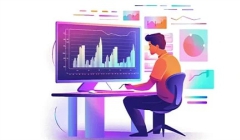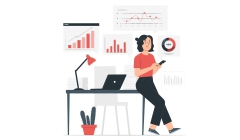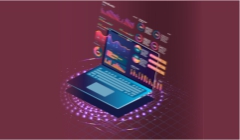
With the world being digital-first, data has become the new oil. Companies base strategic decisions, optimize operations, and forecast trends on insights gained from data. The data-driven culture has hugely raised the need for qualified data scientists, establishing data science among the most rewarding and future-proof professions. If you're looking to get into this profession, knowing the step-by-step career path to be a data scientist is crucial. This roadmap will walk you through each phase of your journey—no matter if you are a student, working professional, or career changer.
Data Science Roadmap Overview
Here's an overview of the major steps:
Step 1: Understand What Data Science Is
Before getting into the technicalities, it is essential to know the field you are entering.
Data Science is a cross-disciplinary field that employs scientific approaches, algorithms, and systems to extract insights and knowledge from data. It draws on aspects from:
Typical roles in data science:
Step 2: Learn the Prerequisites – Math and Statistics
Mathematics and statistics form a solid foundation for learning algorithms and data interpretation.
Key topics to learn:
Tips:
Step 3: Learn Programming – Python or R
Programming is an essential skill for data workflow automation, data analysis, and ML model construction.
Languages of choice:
Key concepts:
Step 4: Learn Data Handling and Preprocessing
Real-world data tends to be messy, missing, or inconsistent. A good data scientist is skilled in cleaning, preparing, and wrangling data.
Key skills:
Tools and libraries:
Pro Tip: Always inspect your dataset prior to analysis with descriptive statistics and visual plots.
Step 5: Learn Data Visualization
Visualization is essential to present your findings and insights in a proper manner.
Popular packages:
Plots to learn:
Step 6: Learn Machine Learning
Machine Learning (ML) is the backbone of data science. It enables systems to learn from data and make decisions without explicit programming.
Major topics:
Advanced tools:
Real-world applications:
Step 7: Build Real-Time Projects and Portfolio
Creating real-world projects helps reinforce your skills and showcases your expertise to recruiters.
Sample projects:
Tips:
Step 8: Take a Data Science Certification or Course
A formal course or certification can accelerate your learning curve and enhance your resume.
Seek programs that include:
Career and interview assistance
Course delivery formats:
Step 9: Learn Advanced Concepts (Optional but Valuable)
To grow further in your career or tackle more complex problems, dive into advanced topics:
These skills are especially valuable in product-based companies and AI-focused startups.
Step 10: Find Internships, Jobs, and Freelance Work
Now that you have your basics and projects set, begin searching for real-world work opportunities.
Job roles to search for:
Where to search for roles:
Tips for interview preparation:
Keep your resume and GitHub up-to-date
Step 11: Participate in Data Science Communities and Competitions
Being part of online communities and hackathons hones your skills and also broadens your connections.
Groups to be joined:
Platforms to be tried:
Advantages:
Step 12: Continue Learning and Adapting
The data science field progresses rapidly. New tools, libraries, and methods are introduced on a regular basis.
Keep yourself updated by:
Your long-term plan should involve:
FAQs – Roadmap to be a Data Scientist
Q1. Is it possible to become a data scientist without a CS background?
Yes. Anyone who is strong analytically and willing to learn can be a data scientist, irrespective of the degree.
Q2. How long does it take to be a data scientist?
It takes about 6 to 12 months of regular learning and practice for a beginner to be job-ready.
Q3. Do I need a master's degree?
No. Helpful, but not necessary. Skills, projects, and certifications are more important in most organizations.
Q4. Do I have to learn all programming languages?
No. Master one (better Python) and become a master in it.
Q5. Are freshers eligible to be data scientists?
Yes. Most companies recruit freshers for junior data science or analyst positions if they show skill and potential.

Over the last few years, data science has become one of the most fulfilling and promising of all careers across industries in India. For those who have graduated from the streams of B.Tech ECE (Electronics and Communications Engineering), making a switch to data science might look unconventional but is now fast becoming a rational and realizable career transition. With analytical strength, exposure to programming, and a grasp of mathematical principles, ECE students have an excellent chance of being data-driven professionals. Wondering how to be a data scientist in India after B.Tech ECE? This blog is your complete guide.
Why are ECE Students a Good Fit for Data Science?
Electronics and Communication Engineering students usually develop a foundation in:
All these fundamental concepts are of great importance in data science, particularly in fields such as machine learning, natural language processing, and data modeling.
Quick Roadmap to Become a Data Scientist After B.Tech ECE
Below is a concise step-by-step guide to transitioning into data science:
Step-by-Step Solution for Becoming a Data Scientist after B.Tech ECE
1. Learn the Scope of Data Science
What is data science? It is a multi-disciplinary domain that uses statistics, computer science, and domain expertise to derive insights from structured and unstructured information. A data scientist is involved in gathering, analyzing, and interpreting large data sets to support businesses in making data-driven decisions.
Trending terms: scope of data science in India, data scientist salary in India, what does a data scientist do
Why it matters:
2. Improve Your Programming Skills
Most data science processes involve programming to automate data activities, create models, and visualise outputs.
Best programming languages for data science:
Learning sequence:
3. Establish a Solid Math and Stats Background
Mathematics is the foundation of data science. You need to go back and reinforce ideas you studied in your B.Tech ECE.
Major concepts to review:
Why this is important: They're the basics to learn about how algorithms operate and how to analyze them.
4. Master Data Manipulation and Analysis Tools
After you feel comfortable with Python and stats, shift to manipulating and analyzing data itself.
Things to learn:
Use case: Parse and clean raw sensor data from an IoT device (a skill that crosses over your ECE experience to data science).
5. Master Data Visualization Tools
The skill to present data insights visually is essential in data science.
Best tools and libraries:
Tip: Imagine datasets related to ECE such as frequency vs. amplitude or network signals.
6. Immerse in Machine Learning
Machine Learning (ML) is an essential aspect of data science and allows computers to learn patterns from data.
Key areas to explore:
7. Practice on Real Projects and Create a Portfolio
A well-organized project portfolio demonstrates your skills more effectively than a resume.
Project ideas for ECE graduates:
Where to host your portfolio:
8. Look into Professional Certifications or Data Science Courses
While self-study is viable, formal certification courses establish credibility and fill knowledge gaps.
What to look for in a course:
Popular formats:
9. Prepare to Interview and Apply for Entry-Level Positions
Begin by applying for the following positions:
Interview preparation tips:
Pro tip: Start by applying at startups, analytics companies, and IT services firms.
10. Keep Up with Current Trends
Data science is a rapidly changing domain, so constant learning is necessary.
Keep up to date with:
Common FAQs – Career Switch to Data Science After B.Tech ECE
Q1. Can I switch to data science without a computer science degree?
Yes. Many successful data scientists come from non-CS backgrounds like ECE, Mechanical, and Civil Engineering. Your analytical mindset and problem-solving skills matter more than your degree.
Q2. Is a master’s degree required?
Not really. Skills are valued more than degrees by most companies. But an M.Tech or online MSc in Data Science can be a booster for your profile.
Q3. What is the typical data scientist salary in India?
Data scientists starting out in India get a salary between ₹6 LPA to ₹10 LPA, and the salary goes up quite a bit with experience and domain knowledge.
Q4. How long would it take to change careers?
With dedicated effort, you can make the transition in 6 to 12 months. A solid plan and project portfolio can speed up your transition.
Final Words – Your ECE Background is a Strength, Not a Barrier
Transitioning from ECE to data science can look intimidating, but it's a very feasible and sensible career path in today's digital economy. You already possess the analytical abilities, programming exposure, and mathematical foundations to excel at data science.
Whether you opt for self-learning, online certification, or training through mentorship, your path to becoming a data scientist in India begins with one small step—picking up the initiative to start.
And recall, in the era of AI, the real degree is learning. With commitment, the appropriate learning pathway, and hands-on experience, you can create a successful career as a data scientist, be it any branch of engineering.

In the modern world of data, companies depend significantly on data scientists for extracting actionable information, making data-driven decisions, and creating predictive models. With enormous opportunities for jobs, competitive pay, and the increasing importance of artificial intelligence and machine learning, numerous upcoming professionals are in quest of methods to initiate a career in data science. Being one of them and looking to kickstart your career in data science, this complete guide is designed especially for you.
Whether you’re a student, recent graduate, or a working professional looking for a career switch, entering the field of data science is achievable with the right mindset, strategy, and skills.
Before diving into how to begin your journey, it's essential to understand why data science is a highly sought-after career:
Most Important Skills to Begin a Data Science Career
To be a data scientist, you need to have a good foundation in various skills. These are the essential skills:
Soft skills: communication, critical thinking, storytelling with data
Step-by-Step Guide to Begin a Career in Data Science
1. Learn What Data Science Is
Data science is an amalgamation of statistics, programming, and domain knowledge. Begin by learning about:
This basic understanding keeps you motivated and focused during your journey.
2. Evaluate Your Background and Establish Goals
Regardless of a technical or non-technical background, a data science career can be pursued with proper learning.
Engineering/IT Background: Emphasize statistics, machine learning, and domain knowledge.
Non-Tech Background: Begin with programming basics and data analysis before progressing.
Establish SMART goals:
3. Select a Learning Route That Suits You
Based on your budget, time, and learning style, here are the choices:
Make sure the learning route involves practical projects, datasets, and exposure to real-world case studies.
4. Dominate the Tools and Technologies
A data scientist's toolkit contains:
Hands-on practice with these tools is essential to gaining confidence.
5. Concentrate on Mathematics and Statistics
Mathematics forms the core of data science. Concentrate on:
It makes you comprehend the reasoning behind machine learning algorithms and data analysis.
6. Go Deep into Machine Learning and AI
After you're familiar with the fundamentals, look into:
7. Work on Real-Life Projects
Developing a portfolio is important for job applications. Project types:
Make use of public datasets found on platforms such as Kaggle or UCI Machine Learning Repository.
8. Create a Data Science Portfolio
Your portfolio is a representation of your technical expertise and problem-solving skills. Add:
9. Learn from the Community
Be surrounded by other learners and professionals:
Being part of a community keeps you motivated and in the know.
10. Prepare for Interviews
Once you're job-ready, work on:
Frequently Asked Questions (FAQs)
Q1: Is it possible for a non-programmer to become a data scientist?
Yes, anyone is capable with focused learning and hard work, and they can learn basic programming and transition to data science.
Q2: Does one need a degree in data science?
No, it is not required. Most data scientists are either self-taught or have completed online certification programs.
Q3: How long will it take me to become job-ready?
Usually, 6–12 months of intense learning and practice is sufficient to secure an entry-level position.
Q4: What are the job titles that I can pursue?
Career Transition Routes Into Data Science
If you already have a different career background, here's what to do:
From Software Development
From Business/Finance
From Academia or Research
From Marketing
Certifications and Courses That Help
Getting certified lends credence. Search for:
Job Hunting Tips
After feeling comfortable with your abilities, follow these:
Final Words: Start Now, Grow Continuously
Pursuing a career in data science can be daunting at the beginning, but with a guided process and continuous learning, it is possible. Concentrate on developing core skills, obtaining hands-on experience, and demonstrating your work through projects and a strong portfolio.
With this data age, businesses are always looking for experts to interpret big datasets and make sense of them, leading to insights that inform decisions. This is your moment to shine.